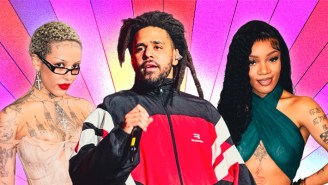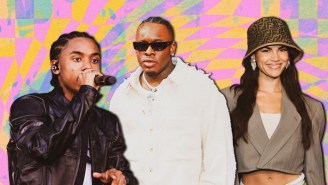Struggle is a part of life. Sometimes we forget that when we’re looking at professional basketball players. They make so much money, they’re so talented, and there’s so much hype around players changing teams that it’s easy to overlook how much harder a transition can be than just putting on that shiny new jersey.
There are better indicators to telling how the new guy in town’s going to fare besides how he looks in the new uniform. It’s still all a matter of fit, though. Players have skills and teams have schemes. Sometimes the two don’t mix as well as everyone thought they would on media day. With training camp here, let’s take a look at some players who may have a harder than expected time adjusting to their new surroundings.
*** *** ***
5. ANDRE IGUODALA, Denver
The reason Iguodala finds himself on this list is more of a situational struggle than any fault of Iggy himself. What he brings to the table is pretty well defined at this point. He’s an elite perimeter defender, a plus rebounder and scorer, and one of the game’s most capable passers when used in a point forward capacity. These advantages lead into his downfall, which is that his skillset clearly puts him at a sort of Pippen-level second option on a championship team, or a super third-wheel type player in a “big three” scheme.
Watching Iggy play for Team USA in the World Championships last year, and again this year in the Olympics, was a beautiful experience. He plays incredible team basketball. I always hoped that when he moved on from Philadelphia, he’d end up somewhere alongside a dominant scoring option.
Instead he ended up in Denver, a place where his skillset is a definite upgrade, yet also already somewhat redundant. It’s worth remembering that while Iguodala is considered a large upgrade at the wing position for Denver, he may end up taking more off the table and interrupting the Nuggets offensive flow. He improved his three-point shooting markedly last year and still only clocked in at around 39 percent from beyond the arc, his career best. Iguodala could start at shooting guard, and with Kenneth Faried likely starting at power forward, that leaves only Ty Lawson and Danilo Gallinari as legitimate three-point threats.
He will fit right in with the running style that has always been present in Denver, shooting 79 percent in fast-break situations in which he is not handling the ball. Assuming the Nuggets keep their pace, which was the second-highest in the entire league last year, he should be able to contribute efficiently on offense. The problem is that he will contribute in a vastly different way than Arron Afflalo, helping the team on defense and in transition but eliminating the three-point shot that marks Denver’s half-court offense.
While the Nuggets get better with the addition of Iggy, they don’t improve enough to take the leap into the title discussion. Because of this, Iguodala’s season will be unfairly considered a disappointment. He won’t meet the expectations, so his efforts this year will be considered a struggle. His actual transition might go smoothly, but it will be severely overshadowed.
4. O.J. MAYO, Dallas
O.J. Mayo is free. Well, kind of. After two years of being a bench hurricane for the Grizzlies, he finally gets his chance at big minutes (and big scoring) in Dallas. However, O.J. is one of those players whose minutes have fluctuated throughout his career and who’s per-36 minute statistics have remained relatively static. In his first two years, when he was averaging around 19 and 18 points per game, respectively, he was also playing 38 minutes per game. Last year he averaged about 13 points and played 27 minutes a game. In terms of per-36 minute production, he averaged roughly the same scoring, rebounding and assiting numbers. So it stands to reason that we really shouldn’t expect much bigger things out of Mayo this year than we saw his first two years… unless, of course, his situation were to improve.
But by moving from a floor-manager style of point (Mike Conley) to Darren Collison as his running mate, O.J. falls into a situation in which it will be harder for him to be a fluid part of the offense. Collison had his fun as a Chris Paul plugin, it looks, and has regressed ever since then. He averaged a shade under five assists per game last year and assisted on a full five percent less of all scoring then Mayo’s old point guard, Conley.
Point guards like Collison are wonderful to have on a team if there’s a guy who’s a capable secondary passer. The ultimate example is Mario Chalmers, who turned into a relatively good player because the passing acumen of LeBron James gives him more freedom to score and takes away the stress of getting the ball to others.
It’s no fault of O.J. Mayo that he isn’t a secondary or lead passer. We saw it when Memphis tried to pass him off as a point in summer league. It just didn’t work – even though he did manage to assist on 16 percent of Memphis’ scoring last year – because that’s simply not who he is. Mayo screams volume scorer, which can either be a good or very bad thing. His ceiling seems to be more of a Joe Johnson-esque stat-line, with the points always being present but rarely eclipsing 4-5 rebounds and assists.
On a team with a dynamic and well-run offense, Mayo could likely hit the 20-25 points per game plateau that players like Danny Granger have. But on the Mavericks, he could be a static piece of a relatively anemic offense. It’s very possible that he could develop an “Iso-Joe” problem in Dallas, where he shoots a lot (out of necessity) at a relatively low percentage. While his numbers stand to increase, there also stands to be a decline in his efficiency. Luckily for him, his contract is short, and if it doesn’t work out in big D, the juice can continue to move along until he finds a situation in which he can both start and is not forced to help run an offense. Until then, he will never reach his full potential.
3. BRANDON ROY, Minnesota
It will be great to see Brandon Roy out on the floor again. He was a great player and was always a real joy to watch. But the Portland Trailblazers medical staff diagnosed him with what they deemed a “career-ending” injury before the team amnestied him. This decision came after a series of knee injuries that robbed him of his All-Star status, and reduced him to a situational player who simply couldn’t do the things he was used to being able to do.
From 2010-11, he dropped nearly 10 points in scoring. His field goal percentage dropped all the way down to 40 from 47 percent, and it was a career-worst for him. Even more alarming, he was only able to play in 47 games and was only able to contribute 2.1 win shares.
Now, with a year “pause” to his career, Roy hopes to come back in and return to that All-Star level, but we can only hope for a small miracle or tons of crazy German surgeries. Most would be happy if he could just make it through a season. While hearing about Roy’s return and his signing with a promising Timberwolves’ squad was one of the most enjoyable stories of the summer, watching him limp around the basketball court before his hiatus was one of the saddest sights for basketball fans.
But there are a few things working in his favor. The largest reason is that Roy’s game always had a silkier, sophisticated feel to it. It seems sustainable even with the lack of explosiveness we will see from him. His jumper, unlike his knees, will not erode. He is also landing in a good environment, one in which he brings only his own expectations to the table. Minnesota will be happy to get a capable player out of him and if their decision to bring him in doesn’t work out, the organization will easily push forward.
It all rests on his knees. The last time we saw them on the court, the situation looked bleak. Regardless of all the feel-good that comes from Roy returning to the hardwood, at one point he retired with what was called a “career-ending” knee injury. That cannot be overlooked. He won’t be the same player he once was. He may be savvier, wilier and smarter. He could even be better, but he could also be much worse. All signs point to the latter, even if we’re all hoping for the former.
2. RYAN ANDERSON, New Orleans
The Ryan Anderson breakout party was a real joy to watch. Ever since Dirk Nowitzki, the tall power forward slinking out to the three-point line and knocking down treys has been extremely captivating. A lot of times, though, the big man with a fascination for the longball throws an entire team off. It takes them away from the traditional high percentage, in-the-paint shots, and it makes offensive rebounding an afterthought.
Now, when your team has Dwight Howard, it’s alright to roam around and shoot the hell out of the ball, which is Anderson’s go-to. Dwight makes all things offensive at least plausible because he must always be doubled in the post and on box outs. Anthony Davis may have the potential to one day be as feared, but it won’t be for a while. And while the Brow could be a great rebounder, he also has a tendency to step outside and shoot jumpers. Davis’ length and defensive quickness also make him very enthusiastic about contesting shots outside the painted area, which leaves Anderson alone to protect the glass.
This leaves us with a critical question for the Hornets: who scores in the paint? Al Farouq-Aminu? Occasionally Davis? The Hornets will need Ryan Anderson in the post, a need that is real scary for the prospects of the continuing breakout of Ryan Anderson. While he is capable in the post, a staggering 422 of his 757 total shots were attempted from beyond the arc last season. He converted 166 of those to lead the league in both attempts and makes, but that’s still a ton of possessions that would leave Anthony Davis alone in the paint.
On the defensive end, unless he really develops, Anderson will never be more than just a capable defender and a passable rebounder. He may actually be worse than passable at rebounding, because the shadow of Dwight makes it very easy for the other tall person on the team to crash the boards. Again, Davis may get that respect eventually, but not this year.
By being taken away from his strengths and asked to be what he is not, Anderson will struggle mightily. He will still score the ball well, but everything else is going to be a chore for him. While he will be able to take on more responsibility in his new home, the added responsibility will weigh him down more than it’ll allow him to grow.
1. KYLE LOWRY, Toronto
I have to start out this one by establishing some bias. I love Kyle Lowry. He has that do-it-all flair that I think every single team needs somewhere along their roster. His passing is underrated, as is his rebounding, and he understands he needs to do more than just score to get his team to win. He averaged 14 points and a shade under seven assists last year, while he grabbed about five rebounds and close to two steals a game. He’s also just as effective in the pick-and-roll as Jeremy Lin, who would cause an overload of all Canadian internet if he – instead of Lowry – were traded to the Raptors. So it might be confusing why I have him on this list.
DeMar DeRozan, Landry Fields, Andrea Bargnani, Jonas Valanciunas. Or, as they will come to be known, the dunk contest guy, the one dude who was really good at Hoop Summit, a guy, and Andrea Bargnani. These are the people Lowry has to work with, to mold and win with. While all of these players certainly have usable aspects, they don’t really produce on their own. They need someone to run the show and really flesh out their individual talents in order to be more than just a perennial lottery team.
To be honest, they needed Steve Nash… or at least someone similar to him. And even though I love Lowry, he’s not Nash. Jose Calderon, Lowry’s backup, is more Nash in his passing ability. But Calderon never turned the parts of this team into something fluid, so I see no reason why Lowry could accomplish what Calderon failed to do. Because while Lowry is an exceptional player, he’s just too well-rounded for this team (hear me out). He’s a plug-and-play kind of guy who will bring a whole lot to the table that could make any team better. But his reality is that he’s joining a team with definitive talents, but lacking a clear leader who can put the pieces together. He won’t be the Raptors’ savior, and is at risk of getting lost in the jumble of their roster.
Lowry’s situation will turn him from a player once praised for his ability to do it all with occasional flashes of brilliance into an overlooked player, and it’s a tremendous shame.
Which key new additions will struggle in their new homes?
Follow Rodger on Twitter at @BramleyBeats.
Follow Dime on Twitter at @DimeMag.
Become a fan of Dime Magazine on Facebook HERE.






